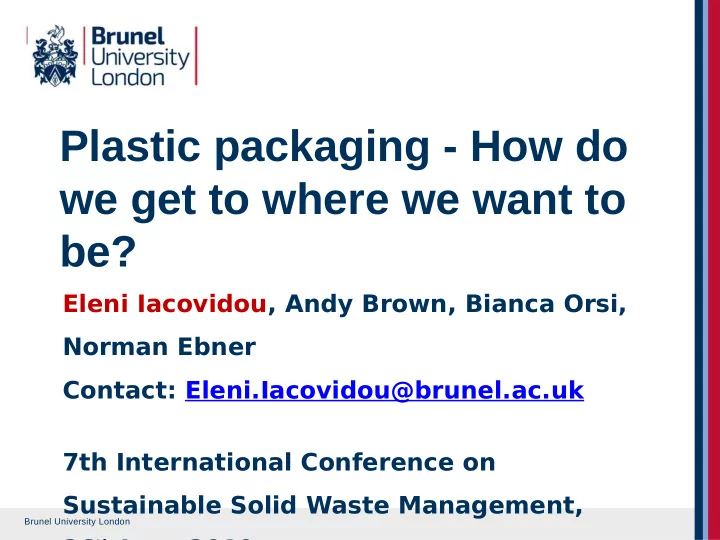

Plastic packaging - How do we get to where we want to be? Eleni Iacovidou, Andy Brown, Bianca Orsi, Norman Ebner Contact: Eleni.Iacovidou@brunel.ac.uk 7th International Conference on Sustainable Solid Waste Management, Brunel University London 26 th June 2019
Scope Sponsored by the Leeds Social Sciences Institute via an Impact Acceleration Award in collaboration with Defra (UK) To assess the plastic packaging waste system by: • Applying the CVORR approach to get an insight into system processes, actors and values • Identifying the challenges in the plastic packaging waste system • Rationalise value and identify/develop key strategic metrics for RR system assessment and monitoring Brunel University London
Whole systems analysis: the only way to bring change Use/Disposa Extraction Production Management l UPSTREAM DOWNSTREAM Point where post-consumer plastic packaging becomes waste Institutional and Economic Technical Environmental Social organisational Brunel University London
The updated CVORR framework CVORR baseline analysis Iacovidou et al. (2017). A pathway to circular economy: Developing a conceptual framework for complex value Brunel University London assessment of resources recovered from waste. Journal of cleaner production , 168 , pp.1279-1288.
Resource recovery system selection Problem definition and UK to increase the: • Recycling of plastic packaging waste to objectives: 70% by 2025, • Average recycled content in all plastic packaging to 30% by 2025. System selection and Plastic packaging system in England. boundaries: Focus: Petrochemical-based plastic packaging that is collected by local authorities (LACMW) Scope: Propose metrics for its assessment and monitoring. Brunel University London
Description of system material flows Brunel University London
Quantification of material flows (i.e. MFA) In 2010/11 around 1,829 kt of plastic packaging waste was collected in England (incl. household and household-like), i.e. LACMW • 18% of collected plastic packaging waste sent to recycling. • 28% sent to energy from waste (EfW) facilities (incl. MBT), ~35% total. • 53% disposed of to landfill. Brunel University London
Why is the recycling rate so low? Multi-layered PET trays, sleeves and in-mould labels, use of different coloured polymers together; no Design / production information on recyclability of the product Confusion over recycling – commingled/separate? inconsistency in the types of plastic packaging collected across England; collectors may refuse to collect plastic Disposal / collection streams that are contaminated - rejection! Contamination (designed and created) is often a problem; aging equipment; low innovation and capability of MRFs/PRFs to sort different types of plastic Sorting packaging Cross-contamination of one polymer by another compromises the quality of the polymers sorted for reprocessing; changes the properties, affects Reprocessing recyclability and value. Hahladakis, J. N. & Iacovidou, E. (2018) Closing the loop on plastic packaging materials: What is quality and Brunel University London how does it affect their circularity? Science of The Total Environment, 630 , 1394-1400.
…and the stakeholders involved Brunel University London
Description of monetary flows Brunel University London
Quantification of monetary flows (per tonne) Brunel University London
So… How do we get to where we want to be? Brunel University London
Reforms start from ‘design / production’ Products are designed for multinational markets Changes in the form and rigidity of packaging could affect the functioning of internal markets and structures Changes in the amount of materials used in the production – more resource efficient. This can lead to material savings, and risks rewarding lighter but not necessarily recyclable materials. It may also increase sales thus leading to increased production. Increasing the use of recycled plastic content in packaging Increases demand in secondary plastic; requires sourcing of good quality plastic packaging waste. Introducing refills made from plastic sachets and laminates Only viable where there is specialised collection, sorting and reprocessing facilities. Brunel University London
Focus on ‘Design-Consumption’ …and also on ‘Collection-Sorting-Reprocessing’ Avoidable Separation at Make packaging source Unavoidable reproces Reduce packaging sing variation in Single use profjtabl collection packaging e-> investme nt Avoid multilayer packaging Minimise coloured packaging Black packaging – new Increase reliance technologies? Labelling on sorting -> investment Reduce losses Avoid use of hot melt adhesives and strong glues, etc. Minimise reliance on landfjll Brunel University London
Feasibility check What can be done in terms of design? Role of markets, consumer purchasing decisions, and EPR in stimulating change, and of the plastic packaging tax. Is there a good infrastructure to support the collection of plastic packaging waste either separately or commingled? Investment to increase consistency in collection across LAs. Is there enough capacity to sort and reprocess increased amounts of plastic packaging waste? Investment to increase capacity – hand-in-hand with changes at collection and design. Is there a strong secondary market domestically and internationally to increase demand of plastic packaging waste in the future? Variable environment – new innovations and price volatility create uncertainty. Brunel University London
Take away messages Tighter environmental regulations in Europe and elsewhere, will require post-Brexit UK to make sure is ahead of the game. Building demand for recycled materials, government and businesses must reinvent their relationship, understand system complexity and make it economically feasible to build secondary materials demand. To connect the downstream with the upstream part of the plastic packaging value chain we need: Coordination across the value chain to realise investments in collection and recycling activities, and technological innovation; Regulatory reforms to influence changes in product design and manufacturing (i.e. packaging reforms); use of taxes and levies on products (i.e. plastic tax), and information based instruments to raise consumer awareness and improve separation at households and minimise litter. Brunel University London
Thank you. Running the system harder will not bring change - we need to change the wheels! Brunel University London
Recommend
More recommend